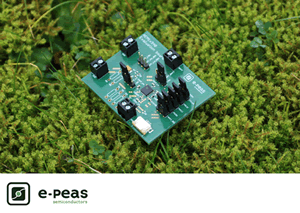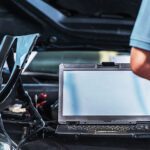Evaluation Board Allows IoT Deployments That Use Ambient Energy
Using AEM10940 technology, IoT power sub-system designs can benefit from elevated conversion efficiencies up to 94%, accelerated supercapacitor charging, and the industry’s lowest cold-start power.
 Ultra-low power semiconductor developer e-peas has introduced the first in a series of products with the objective of revolutionizing power delivery in Internet of Things (IoT) applications, such as remote monitoring and building automation. The AEM10940 evaluation board showcases the company’s proprietary energy management technology, which allows engineers to experiment with the AEM10940 power IC platform and analyze its performance parameters in a controlled, laboratory-like environment. The selection of appropriate key components (such as rechargeable batteries and energy harvesting devices) to accompany it and the setting of the most optimized operating modes can then be decided.
Ultra-low power semiconductor developer e-peas has introduced the first in a series of products with the objective of revolutionizing power delivery in Internet of Things (IoT) applications, such as remote monitoring and building automation. The AEM10940 evaluation board showcases the company’s proprietary energy management technology, which allows engineers to experiment with the AEM10940 power IC platform and analyze its performance parameters in a controlled, laboratory-like environment. The selection of appropriate key components (such as rechargeable batteries and energy harvesting devices) to accompany it and the setting of the most optimized operating modes can then be decided.
Using AEM10940 technology, IoT power sub-system designs can benefit from elevated conversion efficiencies (up to 94%), accelerated supercapacitor charging (approximately three times faster than conventional solutions), and the industry’s lowest cold-start power (requiring the input of just 11μW). The upshot of this is that power extracted from the external environment via some form of energy harvesting (such as photovoltaic cells or thermoelectric generators) can be more effectively utilized. Consequently the expense and inconvenience of having to send staff out into the field to replace batteries can be avoided.
The configurable, ultra-low power boost converter mechanism at the heart of the board (which covers an input voltage range of 100mV to 2.5V) enables the IoT system to build up charge for storage in Li-Ion/Li-Po/thin-film batteries or super-/conventional capacitors. With an input power from 1μW to 50mW, it is able to draw all available harvested energy, no matter how small, with the minimum of losses. The control and status pins are accessed via standard pin headers, facilitating wiring for any conceivable use-case scenario. The flexibility offered by this highly advanced solution means that it can be paired up with the broadest range of components (any form of energy storage and any form of energy harvesting device), thereby ensuring that a fully optimized system is realized. Its streamlined nature also helps keep bill-of-materials costs very low.
“The potential that the IoT sector holds is just starting to become clear, with a multitude of different applications now emerging. A large number of these applications will, however, be in locations where replacing batteries is going to prove difficult. Therefore energy harvesting will need to be employed, which brings its own set of challenges,” says Geoffroy Gosset, CEO and co-founder of e-peas. “Thanks to the high degree of conversion efficiency inherent in our energy management technology, harvested energy can be used much more efficiently. Furthermore, our cold-start capabilities mean that the system can recharge quicker, making it more robust. This evaluation board means that the full scope of this technology may be explored.”
[hr]
- MikroElektronika Intel Joule click shields - May 10, 2017
- Right Angle Board-to-Board Battery Connectors Suit High Shock and Vibration Applications - May 10, 2017
- Compression Pulling Head Family Offers Six Sizes - May 3, 2017






